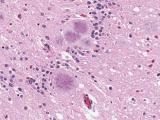June 12, 2006 (CIDRAP News) More people in Britain may be at risk for contracting variant Creutzfeld-Jacob disease (vCJD) than previously thought, according to a study published in the May 20 issue of the British Medical Journal.
The disease is linked to eating meat infected with bovine spongioform encephalopathy (BSE), or mad cow disease. It involves proliferation of a prion protein in the brain, producing plaques and eventually causing death.
The new study, by James W. Ironside and colleagues, has changed thinking about susceptibility to vCJD and has renewed concern about its transmission. The patient samples they analyzed had the VV version of the prion protein gene, a type previously thought to confer protection against vCJD. Although the authors caution against overinterpretation of the results, they assert that their findings may mean that virtually all United Kingdom (UK) residents are at risk for vCJD.
Researchers in the UK had believed that the type of prion protein gene (PRNP) an individual carried (genotype) played a role in susceptibility to the disease. All of the previous deaths from vCJD had occurred in patients who had an MM genotype, or two copies of the M version of the prion gene (PRNP), according to the report.
Individuals who carried at least one copy of the V variant of PRNP (MV or VV genotypes) were thought not to be at risk of contracting vCJD. They constitute about 58% of the British population, according to the article.
Variant CJD was first identified in the UK in 1996. Some early estimates of potential deaths were as great as 136,000, but these were subsequently revised downward when additional studies detected far fewer than the number of cases expected on the basis of experimental disease modeling. Currently, the UK has 161 cases of definite and probable vCJD, with 5 additional patients who are still alive.
Ironside and colleagues analyzed the DNA from samples that had tested positive in earlier immunohistochemical studies of vCJD prevalence in the UK. They had examined a total of 12,674 tissue samples (11,109 appendices, 1,565 tonsils) of patients who had had surgery from 1995 to 1999. Three samples were positive for vCJD.
The researchers extracted DNA from two of the three positive samples; the third did not have sufficient material to obtain DNA. Polymerase chain reaction and restriction analysis was used to detect the genotype of the patients' PRNP at codon 129.
Both positive samples were found to be of the VV type, constituting the first evidence that patients from this genetic subgroup could be infected. Previous studies had detected only MM types among those infected with vCJD, except for one person who had the MV type and apparently acquired vCJD as a result of a blood transfusion.
The investigators suggest that their findings may mean that people who are infected with vCJD and have a VV type may have a prolonged incubation period, during which the disease could spread either via blood donations or from contaminated surgical instruments used on the individuals during the asymptomatic phase of the illness.
Ironside and his group had also investigated the case of the patient who developed asymptomatic vCJD infection after receiving blood from a donor who later fell ill with vCJD. The blood recipient had the MV genotype. (The recipient died of unrelated causes, but disease-associated prion protein was found on autopsy.) The report in 2004 highlighted a potential disease risk to others from blood given by donors with asymptomatic, undetected vCJD.
The authors write that the questions concerning transmission during asymptomatic state in vCJD emphasize the need for continued surveillance for the disorder in the UK and the need for disease modelers to assume that people of all PRNP genotypes are susceptible to vCJD.
Ironside JW, Bishop MT, Connolly K, et al. Variant Creutzfeldt-Jakob disease: prion protein genotype analysis of positive appendix tissue samples from a retrospective prevalence study. BMJ 2006 May 20;332:1186-8 [Full text]
See also:
Jun 1 Eurosurveillance Weekly report "Evidence of a new human genotype susceptible to variant variant CJD"
http://www.eurosurveillance.org/viewarticle.aspx?articleid=2965
Aug 13, 2004, CIDRAP News article "Study implies many more vCJD cases may emerge in UK"
Jul 22, 2004, CIDRAP News article "Another UK patient might have caught vCJD from blood"

















